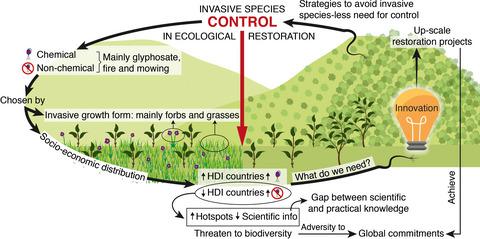当前位置:
X-MOL 学术
›
J. Appl. Ecol.
›
论文详情
Our official English website, www.x-mol.net, welcomes your feedback! (Note: you will need to create a separate account there.)
Controlling invasive plant species in ecological restoration: A global review
Journal of Applied Ecology ( IF 5.7 ) Pub Date : 2020-06-11 , DOI: 10.1111/1365-2664.13656 Emanuela W. A. Weidlich 1 , Flávia G. Flórido 2 , Taísi B. Sorrini 2 , Pedro H. S. Brancalion 2
更新日期:2020-06-11
Journal of Applied Ecology ( IF 5.7 ) Pub Date : 2020-06-11 , DOI: 10.1111/1365-2664.13656 Emanuela W. A. Weidlich 1 , Flávia G. Flórido 2 , Taísi B. Sorrini 2 , Pedro H. S. Brancalion 2
Affiliation

|
- Invasive plant species can hinder the establishment and growth of native plants and impact several ecosystem properties, such as soil cover, nutrient cycling, fire regimes and hydrology. Controlling invasive plants is then a necessary, yet usually expensive, step towards the restoration of an ecosystem. A synthesis of literature is needed to understand variation in invasive plants' impacts and their practical control in restoration contexts, and to identify associated knowledge gaps.
- We reviewed 372 articles published from 2000 to 2019 covering the control of undesirable plants (both exotic invasive and overabundant native plant species) in ecological restoration to gather information on the main plants being controlled and methods used, and considering the distribution of studies among biomes and countries grouped according to the Human Development Index (HDI).
- Grasses and forbs were the most‐studied invasive plant species in restoration sites, but invasive trees were well studied in the tropics. Poaceae and Asteraceae were the most studied families of invasive plants. Non‐chemical interventions (mostly mowing and prescribed fire) were used in more than half of the reviewed studies globally, but chemical methods (mainly glyphosate spraying, used in 40% of projects using herbicides) are also common. The reviewed studies were mostly performed in countries with very high HDI. Countries with low and medium HDI used only non‐chemical methods.
- Synthesis and applications. Decisions about which control method to use depend heavily on the invasive plant species' growth forms, the local economic situation where the restoration sites are located and resources available for control. More developed countries tend to use more chemical control, whereas less developed ones use mainly non‐chemical methods. Since most of the reviewed studies were performed in countries with very high HDI, we lack information from developing countries, which concentrates global hotspots for biodiversity conservation and global commitments of forest and landscape restoration.


























 京公网安备 11010802027423号
京公网安备 11010802027423号